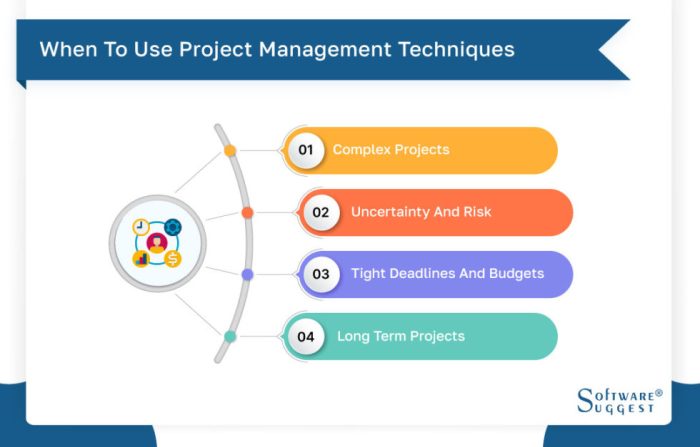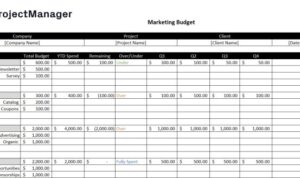Kicking off with Project Management Techniques, this opening paragraph is designed to captivate and engage the readers, setting the tone for a journey through the world of effective project management. From traditional approaches to agile methodologies, we dive into the key strategies that pave the way for successful project completion.
Whether you’re a seasoned project manager or just starting out, understanding these techniques is crucial for navigating the complexities of project execution. Get ready to explore the tools and skills needed to lead your projects to triumph.
Overview of Project Management Techniques

Project management techniques refer to specific strategies and methods used to plan, execute, and monitor projects effectively. These techniques help project managers and teams stay organized, meet deadlines, and achieve project goals within the allocated budget. By implementing the right project management techniques, organizations can improve productivity, reduce risks, and increase overall project success rates.
Common Project Management Techniques
- Agile Methodology: A flexible approach that focuses on iterative development, allowing teams to respond to changes quickly.
- Waterfall Method: A linear and sequential approach where each phase must be completed before moving on to the next.
- Critical Path Method (CPM): A technique used to identify the longest sequence of dependent tasks to determine the minimum project duration.
- Scrum Framework: An iterative and incremental framework that emphasizes collaboration, accountability, and continuous improvement.
- PERT Analysis: Program Evaluation and Review Technique used to estimate the time required to complete a project.
Importance of Effective Project Management Techniques
Effective project management techniques are crucial for successful project completion as they help in:
- Setting clear objectives and goals for the project.
- Allocating resources efficiently to meet project requirements.
- Monitoring progress and identifying potential risks and issues early on.
- Improving communication and collaboration among team members.
- Adapting to changes and ensuring project deliverables meet stakeholder expectations.
Traditional Project Management Approaches: Project Management Techniques
Traditional project management approaches, such as Waterfall or Critical Path Method (CPM), have been the foundation of project management for many years. These methodologies follow a sequential and linear approach to project execution, where each phase must be completed before moving on to the next.
Waterfall Methodology
The Waterfall methodology is a traditional approach where each phase of the project is completed before moving on to the next. This method works well for projects with clearly defined requirements and a fixed scope. However, it can be rigid and less adaptive to changes during the project.
Critical Path Method (CPM)
CPM is another traditional project management approach that focuses on identifying the critical path of a project. It helps in determining the longest sequence of dependent tasks that must be completed on time to ensure the project’s timely completion.
Comparison with Agile Methodologies
Traditional project management approaches like Waterfall and CPM are often compared with agile methodologies. While traditional approaches are more structured and suitable for projects with fixed requirements, agile methodologies are more flexible and adaptive to changes throughout the project lifecycle.
Suitability for Specific Projects
Traditional project management techniques are well-suited for projects with clearly defined requirements, predictable outcomes, and a stable scope. Industries like construction, manufacturing, and engineering often rely on traditional project management approaches due to their structured and sequential nature.
Agile Project Management

Agile project management is an iterative approach to managing projects that focuses on delivering value to the customer in shorter cycles, rather than following a strict plan from start to finish. It emphasizes flexibility, collaboration, and continuous improvement throughout the project lifecycle.
Principles of Agile Project Management
Agile project management is guided by the following principles:
- Customer satisfaction through early and continuous delivery of valuable software.
- Embracing changing requirements, even late in the development process.
- Working together daily throughout the project with stakeholders.
- Delivering working software frequently, with a preference for shorter timescales.
- Building projects around motivated individuals and giving them the environment and support they need.
- Reflecting on how to become more effective and adjusting behaviors accordingly.
- Maintaining a sustainable pace to ensure continuous progress.
Benefits of Agile Project Management
Using Agile project management techniques offers several advantages over traditional methods, such as:
- Enhanced flexibility to adapt to changing requirements.
- Increased collaboration between team members and stakeholders.
- Early and continuous delivery of valuable product increments.
- Improved quality through frequent testing and feedback loops.
- Higher stakeholder satisfaction due to regular updates and involvement in the process.
Examples of Agile Project Management Frameworks, Project Management Techniques
Popular Agile project management frameworks include:
- Scrum: A framework that divides work into time-boxed iterations called sprints, with daily stand-up meetings and regular reviews and retrospectives.
- Kanban: A visual management system that helps teams visualize work, limit work in progress, and maximize efficiency.
- Extreme Programming (XP): Focuses on continuous feedback, testing, and simplicity in development practices.
Risk Management in Projects
In project management, risk management plays a crucial role in ensuring successful project execution. By identifying, assessing, and mitigating risks, project managers can proactively address potential issues that may arise during the project lifecycle.
Significance of Risk Management
Risk management is essential in projects as it helps in anticipating and preparing for potential challenges that could impact project timelines, budget, and quality. By having a structured approach to managing risks, project teams can minimize uncertainties and increase the likelihood of project success.
Techniques for Identifying, Assessing, and Mitigating Risks
Effective risk management involves various techniques such as:
- Brainstorming sessions to identify potential risks
- SWOT analysis to assess the impact of risks
- Probability and impact matrix to prioritize risks
- Risk mitigation strategies like risk avoidance, risk transfer, risk reduction, and risk acceptance
Real-life Examples of Effective Risk Management
One real-life example of effective risk management is when a construction project team identified a potential delay risk due to adverse weather conditions. The team proactively developed a contingency plan by adjusting the project schedule and allocating additional resources to mitigate the impact of the risk. As a result, the project was completed on time and within budget, showcasing the importance of risk management in project success.
Communication Strategies in Project Management
In project management, clear communication is crucial for the success of a project. It ensures that all team members are on the same page, understand their roles and responsibilities, and are aware of project progress and updates.
Importance of Clear Communication
Effective communication techniques play a vital role in project team collaboration. Some of the key strategies include:
- Regular Team Meetings: Scheduled meetings provide a platform for team members to discuss progress, challenges, and next steps.
- Use of Communication Tools: Utilizing tools like project management software, messaging platforms, and email for seamless interaction.
- Active Listening: Encouraging team members to actively listen to each other’s viewpoints and concerns.
- Clear Documentation: Documenting project goals, timelines, and tasks to avoid misunderstandings.
Overcoming Communication Barriers
Communication barriers can hinder project progress. Here are some tips to overcome them:
- Establish Open Communication Channels: Encourage team members to share their thoughts and feedback openly.
- Clarify Expectations: Clearly define roles, responsibilities, and expectations to avoid confusion.
- Address Issues Promptly: Deal with communication challenges as soon as they arise to prevent escalation.
- Provide Feedback: Offer constructive feedback to improve communication skills within the team.





